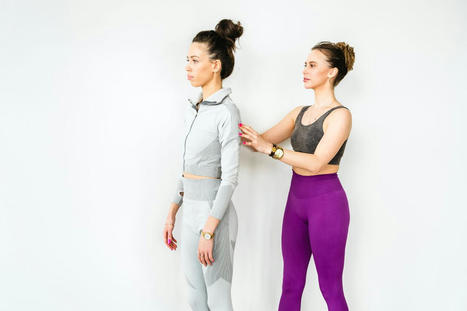For older individuals experiencing posture problems, slumping, slouching, and upper back pain, could adding rib cage exercises help bring relief and prevent the condition from worsening?
Improved Posture
It's common to associate a collapsed upper back posture with age, but other factors can also contribute to the problems. (Justyna Drzał-Grabiec, et al., 2013) The rib cage and the pelvis are important to body structure and comprise much of the core. If these bone structures become misaligned due to unhealthy posture, the muscles that attach to them become tight, weak, or both, and the surrounding muscles have to compensate, causing a worsening of the condition and further injury.
- Unhealthy postures can be caused by a rib cage that compresses down onto the pelvic bone.
- As the upper back slumps or compresses, height can begin to decrease.
- Posture awareness exercises can help lift the rib cage off the pelvic bone.
Rib Cage Exercises
This exercise can be done sitting or standing. A daily routine can help improve posture and relieve back problems and pain.
- The sitting version helps keep the focus on doing the exercise right.
- The standing version challenges body awareness, allowing the individual to feel how the rib cage and upper back movements affect pelvic and lower back posture.
- To begin, it is recommended to start in a sitting position.
- Once the basics are learned, then certainly progress to standing.
Exercise
- Position the pelvis so it is in a slight forward tilt.
- This forward tilt will exaggerate the low back curve slightly while tightening the lower back muscles in a good way.
- Establishing and maintaining this curve in the sitting position should feel natural.
- Inhale and exaggerate the upward lift of the rib cage.
- Inhaling causes the spine and ribs to extend slightly.
- Exhale and allow the rib cage and upper back to return to their natural position.
- Repeat up to 10 times once or twice a day.
- For this exercise, use breathing to develop the rib cage's lift and carriage incrementally.
- Don't max out on the spinal extension.
- Instead, focus on how breathing/inhaling supports the movement of the ribs and upper back and develops the muscles from there.
- Try to lift the rib cage equally on both sides as the body allows.
With practice, individuals will realize the healthy posture changes and increased distance between the ribs and pelvis.
Guidance and Variation
- Perform the exercise with the back against a wall for upper back guidance.
- Another variation of the pelvis and rib cage posture training exercise is to raise the arms.
- This will create a different posture awareness training perspective.
- Focus on rib cage movement when the arms are raised.
- Does lifting the arms make the exercise easier, harder, or different?
- To enhance posture improvement, stretch the pectoral muscles.
Yoga
Individuals looking for more ways to strengthen healthy posture should consider yoga. A study published in the International Journal of Yoga suggests that a great way to activate the core may be to include a variety of yoga postures into the routine. (Mrithunjay Rathore et al., 2017) The ab muscles attach to various places on the rib cage and play a role in posture, alignment, and balance. The researchers identified two muscles, the external obliques, and the transverse abdominal, as key to a healthily aligned posture.
Core Strength
The information herein is not intended to replace a one-on-one relationship with a qualified healthcare professional or licensed physician and is not medical advice. We encourage you to make healthcare decisions based on your research and partnership with a qualified healthcare professional. Our information scope is limited to chiropractic, musculoskeletal, physical medicines, wellness, sensitive health issues, functional medicine articles, topics, and discussions. We provide and present clinical collaboration with specialists from various disciplines. Each specialist is governed by their professional scope of practice and their jurisdiction of licensure. We use functional health & wellness protocols to treat and support care for the injuries or disorders of the musculoskeletal system. Our videos, posts, topics, subjects, and insights cover clinical matters, issues, and topics that relate to and directly or indirectly support our clinical scope of practice.* Our office has reasonably attempted to provide supportive citations and identified the relevant research studies or studies supporting our posts. We provide copies of supporting research studies available to regulatory boards and the public upon request.
We understand that we cover matters that require an additional explanation of how it may assist in a particular care plan or treatment protocol; therefore, to further discuss the subject matter above, don't hesitate to contact Dr. Alex Jimenez or contact us at 915-850-0900.
Dr. Alex Jimenez DC, MSACP, CCST, IFMCP*, CIFM*, ATN*
email: coach@elpasofunctionalmedicine.com
Licensed in: Texas & New Mexico*
References
Drzał-Grabiec, J., Snela, S., Rykała, J., Podgórska, J., & Banaś, A. (2013). Changes in the body posture of women occurring with age. BMC geriatrics, 13, 108. https://doi.org/10.1186/1471-2318-13-108
Rathore, M., Trivedi, S., Abraham, J., & Sinha, M. B. (2017). Anatomical Correlation of Core Muscle Activation in Different Yogic Postures. International journal of yoga, 10(2), 59–66. https://doi.org/10.4103/0973-6131.205515
Papegaaij, S., Taube, W., Baudry, S., Otten, E., & Hortobágyi, T. (2014). Aging causes a reorganization of cortical and spinal control of posture. Frontiers in aging neuroscience, 6, 28. https://doi.org/10.3389/fnagi.2014.00028



 Your new post is loading...
Your new post is loading...








Learn how poor posture can cause upper back collapse, rib cage compression & more. Awareness and posture exercises can help. For answers to any questions you may have, please call Dr. Jimenez at 915-850-0900 or 915-412-6677